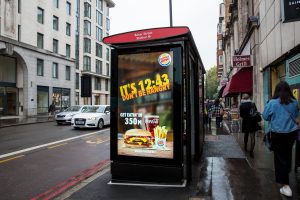 In a fragmented media landscape OOH continues to deliver in both reach (90% reach of adult population) and time spent (three hours a day) with the medium. Alongside this DOOH will reach 50% of revenues but most importantly be able to reach 50% of the adult population.
In a fragmented media landscape OOH continues to deliver in both reach (90% reach of adult population) and time spent (three hours a day) with the medium. Alongside this DOOH will reach 50% of revenues but most importantly be able to reach 50% of the adult population.
OOH is reaching a tipping point where data, technology and the OOH infrastructure will be able to integrate and connect to deliver more impactful, efficient and effective campaigns for clients than ever before. Some of the initiatives we are seeing emerge will only help drive this in 2018:
Location will Become Mainstream
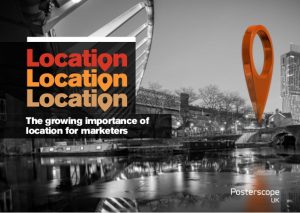 With nearly a third of search queries still related to location, location-based messaging is not merely a trend on the rise but an expected part of service. Advertisers creating dynamic campaigns serving relevant contextual messages are seeing an average uplift of 15% across branding metrics from displaying different messages at different times according to audience context. A single repeated message broadcast in OOH works but new, flexible ways of serving campaigns means multiple messages highly relevant by location will be a strong option for many campaigns.
With nearly a third of search queries still related to location, location-based messaging is not merely a trend on the rise but an expected part of service. Advertisers creating dynamic campaigns serving relevant contextual messages are seeing an average uplift of 15% across branding metrics from displaying different messages at different times according to audience context. A single repeated message broadcast in OOH works but new, flexible ways of serving campaigns means multiple messages highly relevant by location will be a strong option for many campaigns.
Integration with Mobile will Increase
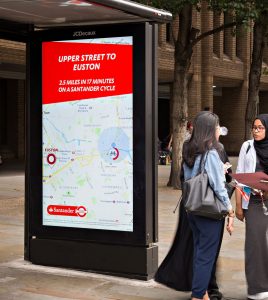 Touchpoints data shows that 99% of smartphone owners use their devices whilst OOH in any given week. Brands like KFC are already tapping into this by incorporating Snapcodes into OOH campaigns to drive reach and engagement like never before. Combining the two channels makes sense for consumers who already exhibit these behaviours and is appealing for brands who can link them to CRM data and track attribution in new ways. New OOH formats such as public WiFi, phone chargers, beacons and more will strengthen the alignment between OOH and mobile.
Touchpoints data shows that 99% of smartphone owners use their devices whilst OOH in any given week. Brands like KFC are already tapping into this by incorporating Snapcodes into OOH campaigns to drive reach and engagement like never before. Combining the two channels makes sense for consumers who already exhibit these behaviours and is appealing for brands who can link them to CRM data and track attribution in new ways. New OOH formats such as public WiFi, phone chargers, beacons and more will strengthen the alignment between OOH and mobile.
Automation will drive efficiency
Automation in the media world has various definitions but a key benefit is efficiency. Lead times are reduced, activation sped up and time previously spent on manual tasks can be freed up to out-think competitors. Advertisers will take advantage of live OOH availability allowing more efficient buys and making investments go further in a tried and tested channel.
Smarter Data Sets will Inform Smarter Campaigns
 Brands invest in understanding who visits their real-estate (online or otherwise) and can often ascribe their customer behaviours to locations. Organisations with huge sets of data, like EE, can apply anonymised and aggregated digital data to the real world to see where people are using social media or browsing sites and apps. 2018 will see smarter use of data sets, that when combined with a brand’s first party data will produce powerful consumer insight and inform smarter campaigns.
Brands invest in understanding who visits their real-estate (online or otherwise) and can often ascribe their customer behaviours to locations. Organisations with huge sets of data, like EE, can apply anonymised and aggregated digital data to the real world to see where people are using social media or browsing sites and apps. 2018 will see smarter use of data sets, that when combined with a brand’s first party data will produce powerful consumer insight and inform smarter campaigns.
Targeting will be driven by context
New data sets and technologies are allowing advertisers to go beyond demographics to understand who is in front of their ad in real-time. Ads can already be triggered by what car people are driving, what brands they are wearing or even their emotional state, driving relevancy to them in that moment. Many DOOH sites have this capability baked-in already and advertisers looking to beat the competition will look to incorporate this type of targeting into their campaigns.
Civic Utility and Ad-Space will Converge
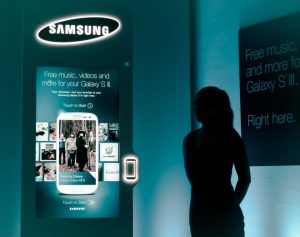 The OOH space is where people go when trying to complete specific tasks. Nowadays it’s not as simple as walking to the shops to complete a task; a range of technology from smartphones to public WiFi is put into use to achieve goals. Civic authorities and media owners are looking to address this with OOH sites getting smarter and going beyond just ad-space to content hubs and technology enablers.
The OOH space is where people go when trying to complete specific tasks. Nowadays it’s not as simple as walking to the shops to complete a task; a range of technology from smartphones to public WiFi is put into use to achieve goals. Civic authorities and media owners are looking to address this with OOH sites getting smarter and going beyond just ad-space to content hubs and technology enablers.
New formats include useful local information like weather forecasts or host local network infrastructure like public WiFi, all designed to enhance the lives of people in the locale. The new functionality of these sites will provide more opportunities for brands and governments to serve, learn and engage local audiences.
New Trading Models will Increase ROI
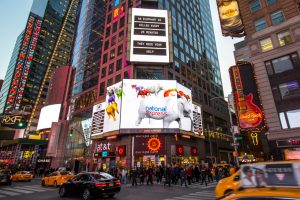 OOH is a tried and trusted medium that continues to build fame and drive action amongst audiences in a broadcast style. New, smarter ways for trading the channel are creating new opportunities for brands to maximise its broadcast capabilities. Previously OOH trading occurred months out from live dates with the exact sites selected up-front with fixed-rate, lump-sum investments.
OOH is a tried and trusted medium that continues to build fame and drive action amongst audiences in a broadcast style. New, smarter ways for trading the channel are creating new opportunities for brands to maximise its broadcast capabilities. Previously OOH trading occurred months out from live dates with the exact sites selected up-front with fixed-rate, lump-sum investments.
Now channel investment can be more flexible with part of campaigns confirmed days before live date rather than months with the advantage of discounted inventory. Campaigns that adopt this approach will drive more efficient purchases and agile adaptation to changing marketing priorities.
Content will Break Through
 By showing content to consumers, rather than explaining product features, advertisers can provide value, letting a product speak for itself in a more powerful and unforgettable way. Content can be useful, creative or contextual but at its core it offers an experience to the consumer, so they can connect with a brand emotionally. In a busy multi-media world where brands must fight to win attention, captivating content-driven campaigns, storytelling and driving results will become far more prevalent.
By showing content to consumers, rather than explaining product features, advertisers can provide value, letting a product speak for itself in a more powerful and unforgettable way. Content can be useful, creative or contextual but at its core it offers an experience to the consumer, so they can connect with a brand emotionally. In a busy multi-media world where brands must fight to win attention, captivating content-driven campaigns, storytelling and driving results will become far more prevalent.
Creative will Focus on the First Impression
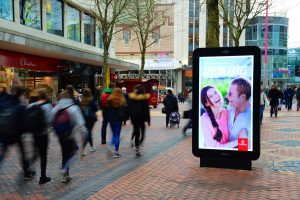 Facebook infamously defined video views at three seconds. That may be deemed appropriate for social views but in OOH where formats are rarely longer than 10 seconds and attention dips after just 0.86 seconds, focusing on the first moment of creative will become critical. OOH already has the foundations for success with unmissable formats and locations, but it will adopt social and digital engagement principles such as short-form formats like GIFs will deliver fast yet captivating experiences.
Facebook infamously defined video views at three seconds. That may be deemed appropriate for social views but in OOH where formats are rarely longer than 10 seconds and attention dips after just 0.86 seconds, focusing on the first moment of creative will become critical. OOH already has the foundations for success with unmissable formats and locations, but it will adopt social and digital engagement principles such as short-form formats like GIFs will deliver fast yet captivating experiences.
2018 will be an important year for OOH that will see new and more flexible ways to plan and trade the medium, more relevant and engaging creative, served at the right time, in the right location, and consequently more return on investment.
Article By Nick Halas, Head of Innovation and Data at Posterscope
 About Nick:
About Nick:
With over 12 years’ digital marketing experience across media agencies, media owners and the telecommunication industry, Nick is a business strategist at heart. With a passion for consumer understanding, data and analytics.
Nick leads global communication strategies, forging new data and product partnerships and creating collaborative synergies across Posterscope’s media partners, with a drive to develop solutions to business problems and to create positive change.
Source: Posterscope

You must be logged in to post a comment Login